Umm Mawagir Ceramics
The unusually dense and plentiful ceramic remains at Umm Mawagir (compare Plate 13) attest to the scale of pharaonic activity at the site — initial figures from our first season of work allow one to estimate approximately 2700 kilograms of pottery within the bakery area alone.
The consistency of ceramic forms and fabrics between the surface remains and the lowest levels of the site indicate that the activity in the area was consistent through the time of use of the site, and was limited to the Thirteenth through Seventeenth Dynasties. Overall the ceramic corpus finds its closest parallels in Second Intermediate Period sites from Dakhla Oasis, including the cemeteries of 32/390-K1-2 and 31/435-D5-21 and Qila’ al-Dabba2 and particularly the urban site of Balat ‘Ain Asîl.3
Khargan Fabrics
Over ninety-nine percent of the ceramic material at Umm Mawagir is of Khargan manufacture, necessitating the creation of a fabric classification for the pharaonic material from the oasis. Unlike Nile Valley potters who utilized both alluvial silts and desert marls, the Khargan potters had access to a variety of shale-based clays that provide the paste for most oasis fabrics.4 Despite the differences in raw material, the Umm Mawagir potters attempted to imitate the distinctions between silts and marls through the addition of various tempers. For that reason, the fabric classification system for pharaonic material from Kharga divides into Oasis Silt Imitations (Group I) and Oasis Marl Imitations (Group II)5. Within these two groups, seven different clay types appear — some of these can be used as either silt or marl imitations depending on the presence or absence of vegetal temper, while others are confined to one of the two major groups. The first four categories (O.10/11, O.21/22/23, O.31/32/33, and O.41) are variants of the oasis clays identified by D. Darnell in her analysis of the fabrics of oasis kegs and flasks from the Theban desert roads.6 Three additional categories encompass specifically pharaonic oasis imitations of different Nile Valley marl clays: O.50 (equivalent to Marl E, for which see below); O.60 and O.61 (used primarily for New Kingdom amphorae7); and O.71 and O.72 (imitations of Marl A3 and Marl A4 respectively). In addition to the abundant shale that characterizes most clays from Kharga Oasis, common inclusions are limestone particles, quartz, and red and yellow particles (most likely red and yellow ochre, but sometimes mudstone and/or shale particles). While the imitation marls typically lack temper or contain added sand, the addition of significant amounts of sand or straw typifies oasis silt imitations; the coarseness of the temper is designated a, b, or c with a mimicking Nile B1, b mimicking Nile B2, and c mimicking Nile C.8
Bread Molds and the Oasis Imitation of an Upper Egyptian Fabric
In all squares thus far examined in the northern portion of Umm Mawagir, bread molds dominate other ceramic forms. These molds belong to two categories: larger, flat-bottomed, round bread molds, later descendants of the heavier Old Kingdom bell-shaped bread molds (Figures 1a); and the far more prevalent twin, “cupcake” bread molds, also with a flat base (Figure 1b-c). The double-bodied bread mold appears to be peculiar to the oases and also appears in large quantities in the SIP settlement of Balat/‘Ayn Asil.9 All of the bread molds are made of a rough, straw tempered oasis marl II.O50 that mimics the Upper Egyptian Marl E,10 and the presence of potter’s wheels within the area of the bakery complex suggest that these vessels were made on-site. In addition to full-size bread molds, three fragments of miniature bread molds were present in squares J31, J34, and K34. Originally measuring about 5 x 2 cm, these small forms occur in both single and double forms, mimicking the two types of full-sized bread molds at the site.11

Potters’ Wheels
The remains of at least two potters’ wheels in the northern portion of the site are of exceptional importance, considering the rarity of such material, and suggest production of the bread molds in the bakery itself. Although stone sockets for potter’s wheels are well attested in Egypt, the associated wheel disks appear only a few times in the published archaeological record of pharaonic sites.12 Two fragmentary ceramic disks were found embedded in the surface of Square K35, inside Structure A, just north of the north wall of Room I. Each disk has a thickened, down-curving, and rounded outer edge, which would have weighted the outside edge of the wheel, increasing its momentum when turning. The larger of the two disks (Figure 2a) has a diameter of 67.2cm and a thickness of 4 cm, which increases to 5.4 cm along the circumference.13 The thickened band around the circumference of the wheel-head appears in two-dimensional representations of potter’s wheels from the Middle Kingdom, such as the depiction of a potter in the tomb of Djehutyhotep at Deir el-Bersha.14
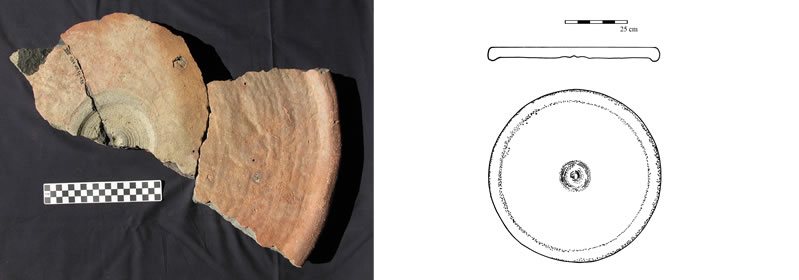
The wear pattern around the center-point of the larger disk (Figure 2) provides clues to the functioning of the Egyptian potter’s wheel prior to the introduction of general adoption of the kick wheel. A small depression (8mm) near the center of the disk’s bottom surface is surrounded by a circular pattern of grooves with a diameter of 12cm. The circular wear pattern on the under-side of the Umm Mawagir disk indicates that it rotated on a pivot; however, if the Umm Mawagir disk was rotating on a fixed pivot, the depression has neither the depth nor the amount of wear expected if the disk were the sole moving element. Two-dimensional depictions of potter’s wheels in Egypt, and actual finds of stone wheel pivots indicate that beneath the wheel head, a stone element with projecting tongue rotated atop a fixed vertical base. Experimental reconstructions have assumed that the disk was immovably attached to the pivot stone,15 and physical evidence suggests that it sometimes was, but the ceramic disk from Umm Mawagir suggests that the disk could rotate freely on the top of the rotating stone pivot as well. The ceramic potter’s wheel at Umm Mawagir is evidence that the Egyptians at times utilized a combination of socketed and pivoted wheel: the disk was loosely socketed into a stone element that pivoted within an additional stone or wooden base. With both moving pivot and wheel head well lubricated, the overall friction of the potter’s wheel would be greatly reduced, increasing the ease of use and longevity of the entire wheel.
Ceramic Vessel Forms
Open Forms
The open forms present at Umm Mawagir consist primarily of hemispherical cups (Figure 3, 4), flat-bottomed cups, and the ubiquitous spouted bowls (Figure 5), so common at oasis sites.16 Hemispherical cups are one of the few forms at Umm Mawagir that appear in small numbers in Nile Valley silt fabric; although Nile B1 cup sherds represent less than 1% of the ceramic corpus in the excavated squares, they are present in small quantities through all levels in the central portion of the site as well as the northern bakery area. The steep sides and slightly everted rims of numerous cups from Umm Mawagir (cf. Figure 3a-c, Figure 4b) find parallels in Thirteenth Dynasty contexts.17

Based on the apparent development of hemispherical cups through the Middle Kingdom, an examination of the vessel indices (height to width ratio) reveals that the Umm Mawagir cups (average vessel index 116.5 from the North Area; average vessel index overall 14018) belong to the end of this development — the late Middle Kingdom/Second Intermediate Period, with a floruit of Umm Mawagir during the Thirteenth Dynasty, although the use of the vessel indices for this period, particularly its latter part, is limited.19 The material from Umm Mawagir may provide an interesting test case for comparisons with the Nile Valley and ceramics of similar date from Dakhleh.20
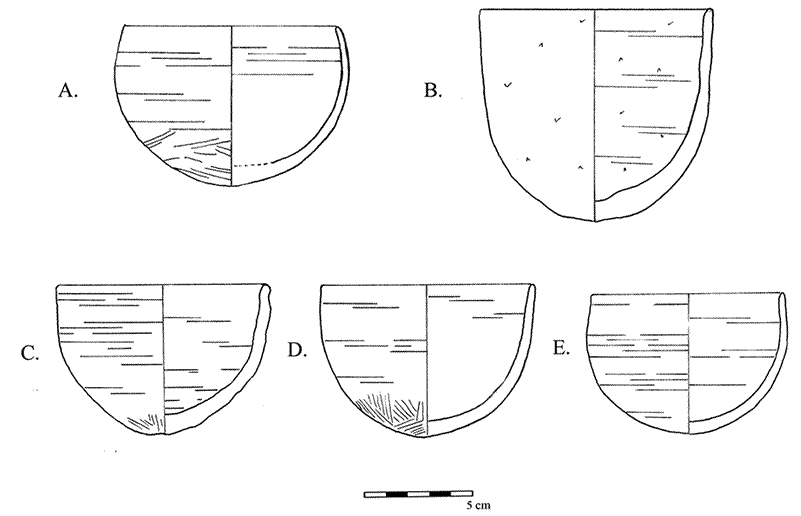
A small group of flat-bottomed cups, apparently with slightly restricted, direct rims (none of these cups are preserved in complete profile), find parallels in a form apparently common in the eastern Nile Delta and North Sinai during the Second Intermediate Period.21 As flat-bottomed cups occur already in early levels at Umm Mawagir, apparently of Thirteenth Dynagsty date, and considering the presence of some flat-bottomed cups belonging to the traditions of the hemispheric cup and spouted bowl at ‘Ain Asîl,22 one may suggest that the appearance of this form in Kharga Oasis and perhaps slightly later in the eastern Delta is the result of parallel local developments of a form having a common Middle Kingdom/late Middle Kingdom origin.
Spouted bowls from Umm Mawagir, like their Dakhla counterparts, display a variety of forms (Figure 5). Some vessels display a sharp carination at the level of the spout, the high carination continuing a Twelfth Dynasty tradition.23 Like so much of the ceramic corpus at Umm Mawagir, the carinated spouted bowl also appears in Second Intermediate Period contexts — both funerary and urban — in Dakhla.24

Jars
The standard jar shape at Umm Mawagir possessed a rim and relatively short neck of Middle Kingdom tradition (Figure 6a-b),25 with globular or slightly oval body, the bottom often departing from the earlier tradition by having a slight point, with exterior scraping along the lower third of the vessel (Figure 6c).26 These latter elements belong to an Upper Egyptian, late Middle Kingdom/Second Intermediate Period tradition. The white splatter painted decoration on a number of jars is unusual, but finds parallels in Second Intermediate Period tombs from Sedment and Thebes (Figure 7a-b)27 Incised wavy-line decoration on the necks of other jars finds numerous Middle Kingdom and Second Intermediate Period parallels in Upper Egypt.28 Jars in Nile Valley fabrics are rare, but diagnostic forms include a Marl A4 neck-to-shoulder of an ovoid jar with three incised lines at the base of the neck (Figure 8a) and part of the body of a Marl A3 variant (Figure 8b), a fabric common in the Theban area during the Second Intermediate Period.29
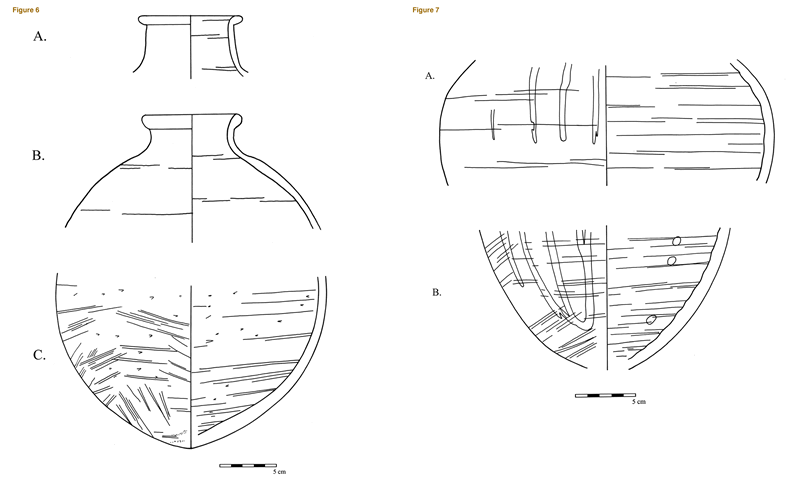

Two unusual jar types common in the Umm Mawagir corpus are squat jars with flaring rims, and medium jars with strongly incurving rims. Some of the squat jars at Umm Mawagir are related to vessels with “candlestick” rims,30 which find parallels at Tell el-Daba from the first third to the end of the ThirteenthDynasty.31Additional squat, biconical cook pots with flaring rims (Figure 9a-c) from Umm Mawagir are similar to vessels in levels dated to the end of the Seventeenth Dynasty at Tell el-Daba,32 and others from Second Intermediate Period tombs.33 Jars with in-turning rims at Umm Mawagir (Figure 9d-f, 10) belong either to vessels with slight “kettle-mouths,” common in Nile Valley34 and oasis35 contexts of the late Middle Kingdom through Second Intermediate Period, or to thinner-walled vessels with severely in-turning rims, representing oasis variants of the “kettle-mouthed” form.36
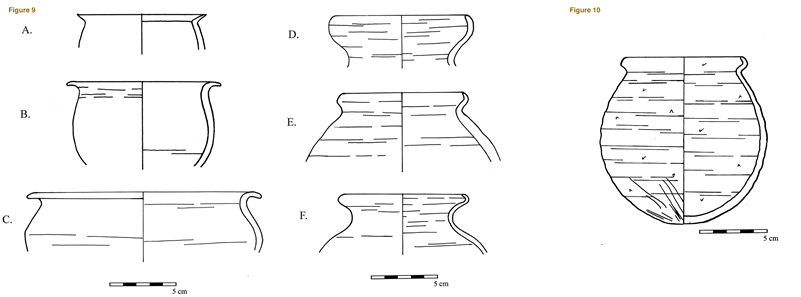
Zirs
The majority of the true zir-forms present at Umm Mawagir belong to the Middle Kingdom tradition (Figure 11a), similar to those we have recorded elsewhere in the general area. Also present is a more cylindrical, straight-walled shape (Figure 11b) that occurs at Nilotic sites alongside zirs with more restricted mouths at least through the time of the late Middle Kingdom; the straight-walled zirs are typically smaller than those of the round-bodied variety. The rim to shoulder portion of a late Middle Kingdom through early Second Intermediate Period storage jar in Nile B237 (Figure 12) from the central portion of the site represents a rare, imported zir.
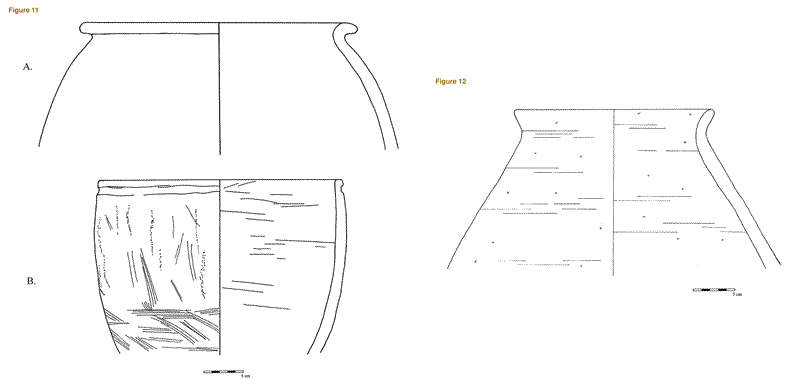
Stands, Lids, and Censors
Pot stands are expectedly common in the Umm Mawagir corpus. In addition to the standard form (Figure 13a-b) and a type with a heavily thickened base,38 a few examples show an odd asymmetry that may represent an intentional form (although they are probably wasters).39 a number of lids with schematic but unmistakable bird’s-head decoration were present, reminiscent of a lid with hippopotamus decoration from Tell el-Daba,40 and identical to the ceramic birds’ heads from ‘Ain Asîl,41 that may also have belonged originally to similar covers. Several fragmentary, hand-shaped objects may be holders for cups used to burn incense.
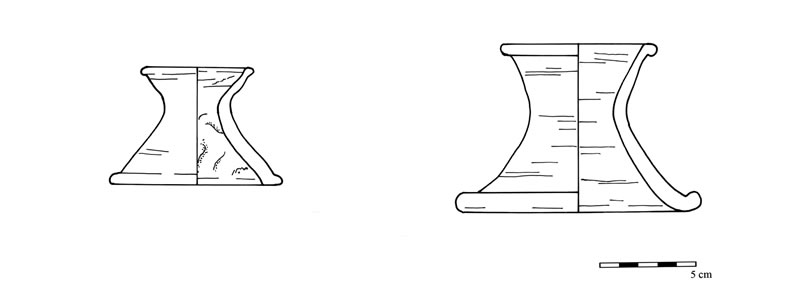
Summary of Ceramic Remains from Umm Mawagir
The ceramic material at Umm Mawagir presents a hybrid of forms and fabrics bridging Middle Kingdom and Second Intermediate Period traditions, and combining forms and surface treatments of an earlier Middle Kingdom style and a later, Theban/Second Intermediate Period tradition. The rough oasis marl II.O50 of the bread molds mimics Marl E, an Upper Egyptian fabric employed for handmade forms — particularly those associated with baking — during the Second Intermediate Period. Viewed as a whole, the ceramic material from Umm Mawagir reveals oasis potters preserving earlier Middle Kingdom forms, perhaps somewhat isolated by political events within the Nile Valley, but having a working knowledge of contemporaneous Upper Egyptian ceramic technology. The ceramic material at Umm Mawagir does not display any of the typical Eighteenth Dynasty forms or surface treatment,42 suggesting that the abandonment of the site was complete by the beginning of the Eighteenth Dynasty.
Notes
- 1. C. Hope, “Dakhleh Oasis Project — Report on the Study of the Pottery and Kilns,” JSSEA 10 (1980): 287-288; idem., Dakhleh Oasis Project — Preliminary Report on the Study of the Pottery — Fifth Season,” JSSEA 13 (1983): 142 – 144.
- 2. S. Aufrère and P. Ballet, “La nécropole sud de Qila‘ al-Dabba (oasis de Dakhla, secteur de Balat). Un palimpseste archéologique,” BIFAO 90 (1990): 1-28.
- 3. M. Baud, “Balat/‘Ayn-Asil, oasis de Dakhla: la ville de la Deuxième Période Intermédiaire,” BIFAO 97 (1997): 35-42; S. Marchand, “La céramique datée de la fin de la XIIIe Dynastie (Deuxième Période Intermédiaire) découverte en contexte artisanal à ‘Ain Aseel (Oases de Dakhleh),” in G. Bowen and C. Hope, eds., The Oasis Papers 3 (Oxford, 2003), pp. 113-122 ; S. Marchand and G. Soukiassian, Un habitat de la XIIIe dynastie — 2e Période Intermédiaire à Ayn Asil. Balat VIII (Cairo, 2010). A more thorough comparison of Umm Mawagir with the ‘Ain Asîl site will appear in future publications of the site.
- 4. For the geology of the oases, see M. Hermina, “The surroundings of Kharga, Dakhla and Farafra oases,” in R. Said, ed., The Geology of Egypt (Rotterdam, 1990), pp. 275-277, 279-282; M. Eccleston, “ Macroscopic and Microscopic Analysis of New Kingdom Dakhleh Oasis Amphorae Fabrics,” in R. Friedman, ed., Egypt and Nubia — Gifts of the Desert (London, 2002), pp. 106-109.
- 5. A division between silt and marl imitations in Khargan pottery was also proposed in D. Darnell, in Friedman, ed., Egypt and Nubia, pp. 169-170. This same feature has long been observed in Dakhla Oasis fabrics — see C. Hope, “Pottery Manufacture in the Dakhleh Oasis”, in C. S. Churcher and A. J. Mills (eds), Reports from the Survey of the Dakhleh Oasis 1977–1987 (Oxford, 1999), p. 226; P. Ballet, “La production céramique,” in G. Soukiassian, et al., Les ateliers de potiers d’‘Ayn-Asil (Cairo, 1990), pp. 75-84.
- 6. “Oasis Ware Flasks and Kegs from the Theban Desert,” Cahiers de la Céramique Égyptienne, 6 (2000): 227-234.
- 7 These two fabrics correspond to the amphora fabrics described in D. Darnell, in Friedman, ed., Egypt and Nubia, pp. 169-170.
- 8. These divisions are similar to those in Ballet, Balat III, pp. 75ff: “céramique fine” and “céramique grossière.”
- 9. Marchand and Soukiassian, Balat VIII, pp. 163-166; Marchand, in Bowen and Hope, eds., The Oasis Papers 3, pp. 116, fig. 5a, 119-120; Baud, BIFAO 97 (1997): 24, 27; a double bread mold was also discovered at Gebel Agg at Toshka, in association with Pan Grave and other Nubian material (currently being studied by Colleen Manassa and Maria Gatto) — see W.K. Simpson, Heka-nefer and the dynastic material from Toshka and Arminna (New Haven 1963), pl. XXII, no. 29. For multi-chambered bread molds of the Second Intermediate Period, see also A. Seiler, Tradition & Wandel, Die Keramik als Spiegel der Kulturentwicklung Thebens in der Zweiten Zwichenzeit (Mainz am Rhein, 2005), pp. 68-69.
- 10. See most recently J. Bourriau, The Survey of Memphis IV, Kom Rabia: The New Kingdom Pottery (London, 2010), p. 26. Kharga fabric II.O51 corresponds to the fabric P4 of the bread molds from “Ain Asîl — see Marchand and Soukassian, Balat VIII, p.153, although they do not make the connection of the recipe for that fabric with Marl E.
- 11. Compare also ‘Ain Asîl — Marchand, in Bowen and Hope, eds., The Oasis Papers 3, pp. 116c, 120; Marchand and Soukiassian, Balat VIII, pp. 166-167.
- 12. C. Powell, “The nature and use of Ancient Egyptian potter’s wheels,” in B. Kemp, ed., Amarna Reports VI (London, 1995), pp. 309-318;For wheel-heads, compare the Old Kingdom example in M. Verner, “The Discovery of a Potter’s Workshop in the Pyramid Complex of Khentkaus at Abusir,” Cahiers de la Céramique Égyptienne 3 (1992): 56.” A wheel-head of a potter’s wheel has also been excavated in a Roman context at Kellis — see C. Hope, “Excavations in the Settlement of Ismant el-Kharab in 1995-1999,” in C.A Hope and G.E. Bowen, eds., Dakhleh Oasis Project: Preliminary reports on the 1994-1995 to 1998-1999 Field Seasons (Oxford.2002), p. 176.
- 13. For the advantages of such a large wheel in pottery production, particularly for wide vessels, see S.E. van der Leeuw, Studies in the Technology of Ancient Pottery (PhD Thesis, Amsterdam, 1976), vol. I, pp. 289-295 and vol. II, pp. 21-28.
- 14. Newberry 1895: pl. 25; see also the discussion in Arnold and Bourriau (eds.) 1993: 57. Interestingly, the ceramic disks from Umm Mawagir are very similar in form to the disks used in Powell’s experimental reconstructions of ancient Egyptian potter’s wheels (Powell 1995: 327-334; the dimensions of the larger disk at Umm Mawagir are surprisingly similar to the test wheel that had the best results in Powell’s experiments — 1995: 330).
- 15. Powell, in Kemp, ed., Amarna Reports VI, pp. 309-318
- 16. C. Hope, “Pottery Manufacture in the Dakhleh Oasis,” in C.S. Churcher and A.J. Mills, ed., Reports from the Survey of the Dakhleh Oasis 1977-1987 (Oxford, 1999), p. 224. Ceramic spouted bowls still form a common element of tableware in Siwa Oasis — see F. Bliss, Artisanat et artisanat d’art dans les oasis du désert occidental égyptien (Cologne, 1998), pp. 202-204.
- 17. C. Hope, JSSEA 13 (1983): fig. 2, e-j; Hope, in Churcher and Mills, ed., Reports from the Survey of the Dakhleh Oasis, p. 226; A. L. Kelley, The Pottery of Ancient Egypt, Dynasty 1 to Roman Times (Toronto, 1976), pls. 49.1 and 49.2; this type of profile is not attested in the published corpus from Ayn Asil.
- 18. A total of 17 complete cup profiles have thusfar been recovered from the two seasons of work at Umm Mawagir; a forthcoming publication will include more complete analysis of the indices and a comparison with the unusual inversion of numbers from Ayn Asil (Marchand and Soukiassian, Balat VIII, pp. 140-141, 180-182).
- 19. Seiler, Tradition und Wandel, pp. 132-135;B. Bader, “A Tale of Two Cities: First Results of a Comparison between Avaris and Memphis,” in M. Bietak and E. Czerny, eds., The Synchronisation of Civilizations in the Eastern Mediterranean in the Second Millennium BC III (Vienna, 2007), pp. 251-254.
- 20. For example, the indices of the hemispherical cups from the Qila‘ al-Dabba cemetery appear to fit well with their Nile Valley counterparts, and burials of Second Intermediate Period date — more specifically Thirteenth Dynasty — at Ain Tirghi (31/435-D5-2) have vessel indices between 150-137 — Hope, JSSEA 13 (1983): 143.
- 21. D. Aston, Tell El-Dab‘a XII. A Corpus of Late Middle Kingdom and Second Intermediate Period Pottery. Volume 1: Text (Vienna, 2004), pp. 199-200 [Group 220]; such vessels do not appear in the published corpus from ‘Ain Asîl.
- 22. Marchand and Soukiassian, Balat VIII, pp. 180-181
- 23. Kelley, Pottery from Ancient Egypt, pl. 38.1, S25c and D67 (Abydos); a carinated spouted bowl from Tell el-Dab‘a has a lower carination and an outward-flaring direct rim — see Aston, Tell El-Dab‘a XII, p.56 andpl. 1.
- 24. Hope, JSSEA 10 (1980): pl. XX, fig. k and l; Hope, JSSEA 13 (1983): fig. 2, b and c; Hope, in Churcher and Mills, eds., Reports from the Survey of the Dakhleh Oasis, p. 226; Marchand, in Bowen and Hope, eds., The Oasis Papers 3, p. 114, Fig. 3a; Marchand and Soukiassian, Balat VIII, p. 193. One of the rare examples of a spouted bowl from the Nile Valley is a silt example from a late Middle Kingdom context at Abydos — Wegner, Senwosret III, p. 261, no. 64.
- 25. Compare Marchand, in Bowen and Hope, eds., The Oasis Papers 3, p. 114, fig. 2g, 119; Marchand and Soukiassian, Balat VIII, pp. 209-212
- 26. A similar combination of characteristics appears in Second Intermediate Period tombs at Dakhleh site 32/390-K1-2 (Hope, JSSEA 10 [1980]: 293-298) and 31/435-D5-2 (Hope, JSSEA 13 [1983]: 143).
- 27. For a white-painted jar at Sedment, see W. F. Petrie and G. Brunton, Sedment I (London, 1924), pl. 45; from the Theban necropolis, compare Seiler, Tradition und Wandel, pp. 86-87 (white bands on “wine jar”) and pp. 80-81 (white dots in bowl).
- 28. Compare W.F. Petrie, Kahun, Gurob, and Hawara (London, 1890), pl. 13; G. Brunton, Qau and Badari III (London, 1930), pls. 15, 17-18
- 29. Darnell and J.C. Darnell, “The Luxor-Farshut Desert Road Survey,” Bulletin de liaison de group international d’étude de la céramique égyptienne, 18 (1994): 46-47
- 30. Aston, Tell El-Dab‘a XII, p. 47; note also taller forms, such as Abd el-Maksoud, Tell Heboua, p. 184, fig. 10, no. V n, 98.
- 31. B. Bader, Tell el-Daba XIII. Typologie und Chronologie der Mergel C-Ton Keramik (Vienna, 2001), pp. 149-150 (“kleine töpfe mit kurzem nach außen gerichtetem Rand”) = Aston, Tell El-Dab‘a XII, p.: 93, pl. 59 (“Group 63: restricted jars with everted rims”); cf. an additional example with incised line decoration in ibid., pl. 157 no. 613.
- 32. Aston, Tell El-Dab‘a XII, pl. 303, nos. 1126-1127
- 33. G. Brunton, Mostagedda and the Tasian Culture (London, 1937), pl. 73, no. 59q and 59s; Armant: R. Mond and O.H. Myers, Cemeteries of Armant I (London1937), pl. 33 no. 37c. According to Seiler, Tradition und Wandel, pp. 146-147 cook pots with slightly everted rims are “common” in the Seventeenth Dynasty, although she lists no specific examples.
- 34. For the increasingly pronounced kettle-mouths during the Thirteenth through Seventeenth Dynasties, see Seiler, Tradition und Wandel,: 128-130. Strongly in-turning rims with thicker walls can appear already in the early Twelfth Dynasty (Bader, Tell el-Dab’a XIII, p.: 101 (fig. f, h), 103); Do. Arnold, “The Pottery,” in Die. Arnold, The Pyramid of Senwosret I, South Cemeteries of Lisht 1 (New York, 1988), p. 134, fig. 74, no. 59, although the examples from Umm Mawagir probably belong to the later development of kettle mouth jars. For Thirteenth through Seventeenth Dynasty forms, see Aston, Tell El-Dab‘a XII, p. 69, pl. 14, no. 73 (Group 24 “jars with round bases and modeled rims”), and pl. 157 no. 612; J. Wegner, The Mortuary Temple of Senwosret III at Abydos (New Haven, 2007), p. 243 no. 45 and p. 244; C. von Pilgrim, Elephantine XVIII: Untersuchungen in der Stadt des Mittleren Reiches und der Zweiten Zwischenzeit (Mainz, 1996), pp. 330-331, fig. 146 b and d; Abd el-Maksoud, Tell Heboua, p. 183, fig. 9.
- 35. Marchand, in Bowen and Hope, eds., The Oasis Papers 3, p. 114, fig. 2h; Marchand and Soukiassian, Balat VIII, pp. 203-204.
- 36. Compare Hope, JSSEA 10 (1980): pl. XX, fig. e
- 37. Compare Bader type 5 = Bader, Tell el-Dab‘a XIII, p. 173; Aston, Tell el-Dab‘a XII, vol. 1, pp. 101-102, and vol. 2, pls. 74-77. 38. Marchand, in Bowen and Hope, eds., The Oasis Papers 3, p. 116, fig. 4a; Marchand and Soukiassian, Balat VIII, p. 225.
- 39. Compare V. Müller, Tell el-Dab‘a XVII, Opferdeponierungen in der Hyksoshauptstadt Auaris (Tell el-Daba) vom späten Mittleren Reich bis zum frühen Neuen Reich, Teil I (Vienna, 2008), vol. 1, 144-145 and fig. 102.
- 40. Müller, Tell el-Dab‘a XVII, vol. 1, 143
- 41. Marchand and Soukiassian, Balat VIII, pp. 256-257.
- 42. Marchand and Tallet, BIFAO 99 (1999): 322-352
